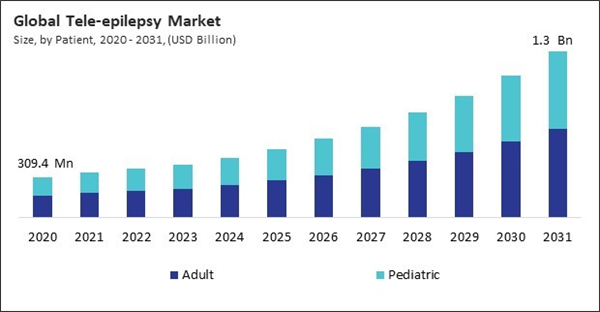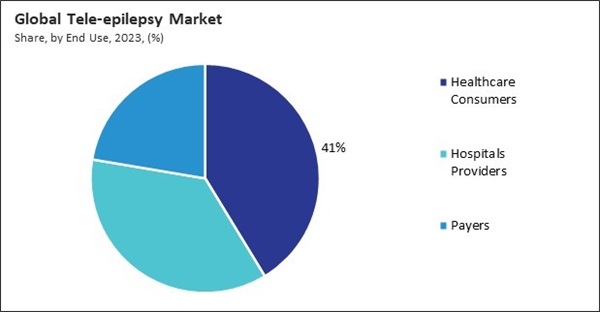The Global Tele-epilepsy Market size is expected to reach $1.3 billion by 2031, rising at a market growth of 15.5% CAGR during the forecast period.
Governments and healthcare organizations in Europe actively support telemedicine initiatives, with robust reimbursement frameworks encouraging tele-epilepsy services. Moreover, Europe’s high healthcare standards and emphasis on innovative treatment solutions make tele-epilepsy an appealing option, particularly for patients seeking specialized care without the burden of frequent travel.
This support for accessible, advanced healthcare has contributed to Europe’s substantial revenue share in the market. Hence, the Europe segment acquired 32% revenue share in the market in 2023. Europe’s tele-epilepsy market has expanded significantly due to the region’s proactive healthcare policies, technological advancements, and increasing public awareness of epilepsy management options.
The treatment process for epilepsy patients is significantly streamlined by digital health tools, such as cloud-based platforms and smartphone applications. These tools offer features such as seizure tracking, medication reminders, and educational resources, encouraging better adherence to treatment plans and enabling patients to be proactive in managing their condition. This data can be accessed remotely by providers, enabling them to make informed decisions without the need for frequent hospital visits. Thus, these advancements are propelling the growth of the market. Additionally, for many underserved populations, tele-epilepsy also enhances continuity of care.
Patients can engage in regular follow-ups and maintain consistent communication with their specialists, which is critical in managing a chronic condition like epilepsy. This continuity allows specialists to monitor treatment efficacy and make adjustments as needed based on real-time data, which can be particularly valuable in optimizing outcomes and preventing complications. Therefore, the ability of tele-epilepsy to reach underserved populations and provide accessible, specialized care is driving the demand for tele-epilepsy.
However, for low-income regions, where healthcare resources are already limited, the costs associated with tele-epilepsy infrastructure can be prohibitive. Many healthcare providers in these areas operate on tight budgets. They may prioritize basic medical needs over investing in advanced digital tools, particularly if there is uncertainty about the return on investment or a lack of government support. Hence, without external support, such as subsidies or grants, these providers may be unable to adopt tele-epilepsy platforms, thus restricting the potential reach and growth of the market.
Governments and healthcare organizations in Europe actively support telemedicine initiatives, with robust reimbursement frameworks encouraging tele-epilepsy services. Moreover, Europe’s high healthcare standards and emphasis on innovative treatment solutions make tele-epilepsy an appealing option, particularly for patients seeking specialized care without the burden of frequent travel.
This support for accessible, advanced healthcare has contributed to Europe’s substantial revenue share in the market. Hence, the Europe segment acquired 32% revenue share in the market in 2023. Europe’s tele-epilepsy market has expanded significantly due to the region’s proactive healthcare policies, technological advancements, and increasing public awareness of epilepsy management options.
The treatment process for epilepsy patients is significantly streamlined by digital health tools, such as cloud-based platforms and smartphone applications. These tools offer features such as seizure tracking, medication reminders, and educational resources, encouraging better adherence to treatment plans and enabling patients to be proactive in managing their condition. This data can be accessed remotely by providers, enabling them to make informed decisions without the need for frequent hospital visits. Thus, these advancements are propelling the growth of the market. Additionally, for many underserved populations, tele-epilepsy also enhances continuity of care.
Patients can engage in regular follow-ups and maintain consistent communication with their specialists, which is critical in managing a chronic condition like epilepsy. This continuity allows specialists to monitor treatment efficacy and make adjustments as needed based on real-time data, which can be particularly valuable in optimizing outcomes and preventing complications. Therefore, the ability of tele-epilepsy to reach underserved populations and provide accessible, specialized care is driving the demand for tele-epilepsy.
However, for low-income regions, where healthcare resources are already limited, the costs associated with tele-epilepsy infrastructure can be prohibitive. Many healthcare providers in these areas operate on tight budgets. They may prioritize basic medical needs over investing in advanced digital tools, particularly if there is uncertainty about the return on investment or a lack of government support. Hence, without external support, such as subsidies or grants, these providers may be unable to adopt tele-epilepsy platforms, thus restricting the potential reach and growth of the market.
Driving and Restraining Factors
Drivers
- Rising Number of Epilepsy Cases Worldwide
- Advancements in Telemedicine Technology
- Growing Demand for Access to Specialist Care
Restraints
- High Cost of Telemedicine Infrastructure
- Limited Internet Access and Connectivity
Opportunities
- Supportive Government Policies and Reimbursements
- Increasing Awareness and Acceptance
Challenges
- Data Privacy and Security Concerns
- Lack of Skilled Professionals
Patient Outlook
Based on patient, the market is bifurcated into adult and pediatric. The adult segment garnered 55% revenue share in the market in 2023. The adult segment in the market is primarily driven by the high prevalence of epilepsy among adults and the increasing adoption of telemedicine for managing chronic conditions. Many adults with epilepsy benefit from the flexibility and convenience of remote care, allowing them to consult specialists, receive regular monitoring and manage their condition without frequent in-person visits.End Use Outlook
On the basis of end use, the market is classified into healthcare consumers, hospital providers, and payers. The hospital providers segment recorded 36% revenue share in the market in 2023. The hospital providers segment is driven by hospitals' adoption of tele-epilepsy platforms to expand their services and provide specialized epilepsy care to a broader patient base. Hospitals are increasingly integrating tele-epilepsy into their offerings to reduce the burden on emergency departments, manage epilepsy cases more efficiently, and attract patients who seek reputable facilities with remote care options.Component Outlook
By component, the market is divided into software, hardware, and services. The hardware segment witnessed 40% revenue share in the market in 2023. Essential components such as cameras, microphones, EEG devices, and other monitoring hardware enable accurate assessments and ongoing management of epilepsy patients from a distance. As tele-epilepsy becomes a preferred solution for many, especially in rural or underserved areas, the demand for durable, user-friendly hardware has surged, making it the highest revenue-generating segment.Regional Outlook
Region-wise, the market is analyzed across North America, Europe, Asia Pacific, and LAMEA. The North America segment procured 36% revenue share in the market in 2023. Supportive government policies and widespread insurance coverage for telemedicine services, including epilepsy care, have driven adoption among patients and providers alike. The presence of major healthcare providers and tech companies developing advanced tele-epilepsy platforms has also propelled this region to capture the highest revenue share.List of Key Companies Profiled
- Shimmer Research Ltd.
- Emotiv Inc.
- CortiCare, Inc.
- SEVARO
- Tele Specialists
- Real Time Tele-Epilepsy Consultants
- ScienceSoft USA Corporation
- Zeto, Inc.
- TeleEEG
- Epitel, Inc.
Market Report Segmentation
By Patient
- Adult
- Pediatric
By End Use
- Healthcare Consumers
- Hospitals Providers
- Payers
By Component
- Software
- Hardware
- Services
By Geography
- North America
- US
- Canada
- Mexico
- Rest of North America
- Europe
- Germany
- UK
- France
- Russia
- Spain
- Italy
- Rest of Europe
- Asia Pacific
- China
- Japan
- India
- South Korea
- Australia
- Malaysia
- Rest of Asia Pacific
- LAMEA
- Brazil
- Argentina
- UAE
- Saudi Arabia
- South Africa
- Nigeria
- Rest of LAMEA
Table of Contents
Chapter 1. Market Scope & Methodology
Chapter 2. Market at a Glance
Chapter 3. Market Overview
Chapter 4. Global Tele-epilepsy Market by Patient
Chapter 5. Global Tele-epilepsy Market by End Use
Chapter 6. Global Tele-epilepsy Market by Component
Chapter 7. Global Tele-epilepsy Market by Region
Chapter 8. Company Profiles
Companies Mentioned
- Shimmer Research Ltd.
- Emotiv Inc.
- CortiCare, Inc.
- SEVARO
- Tele Specialists
- Real Time Tele-Epilepsy Consultants
- ScienceSoft USA Corporation
- Zeto, Inc.
- TeleEEG
- Epitel, Inc.
Methodology

LOADING...










